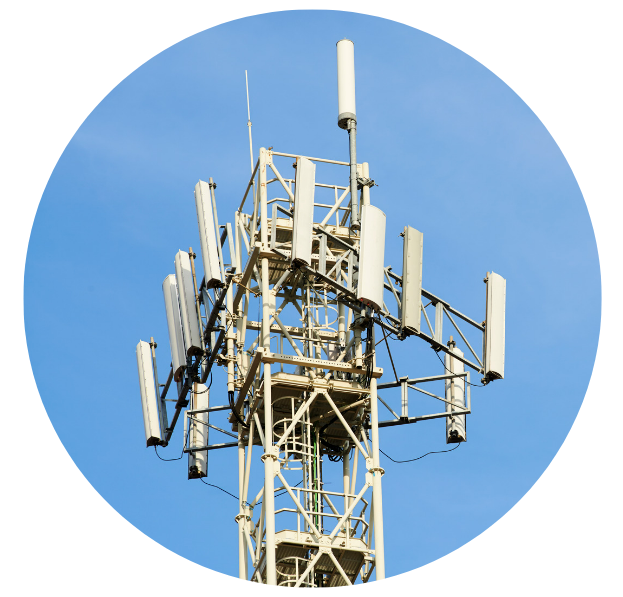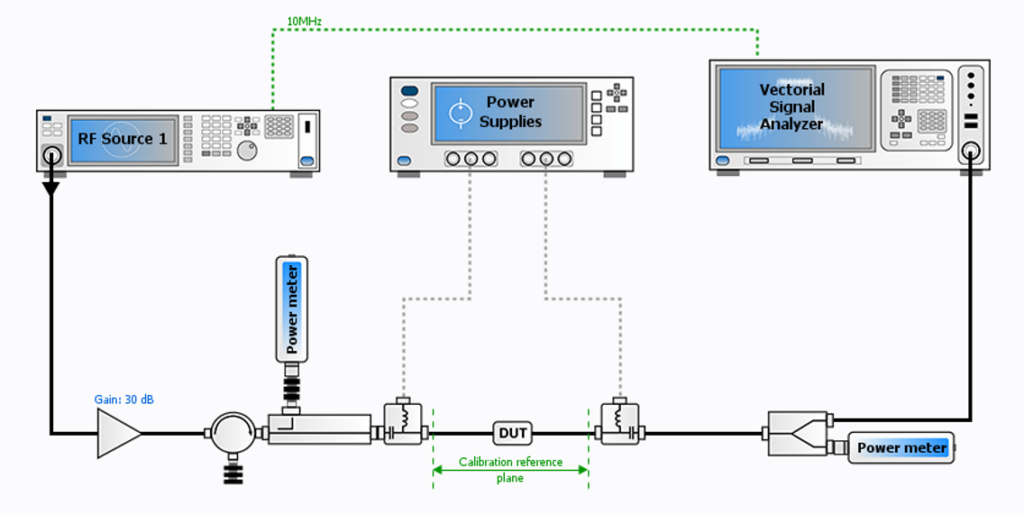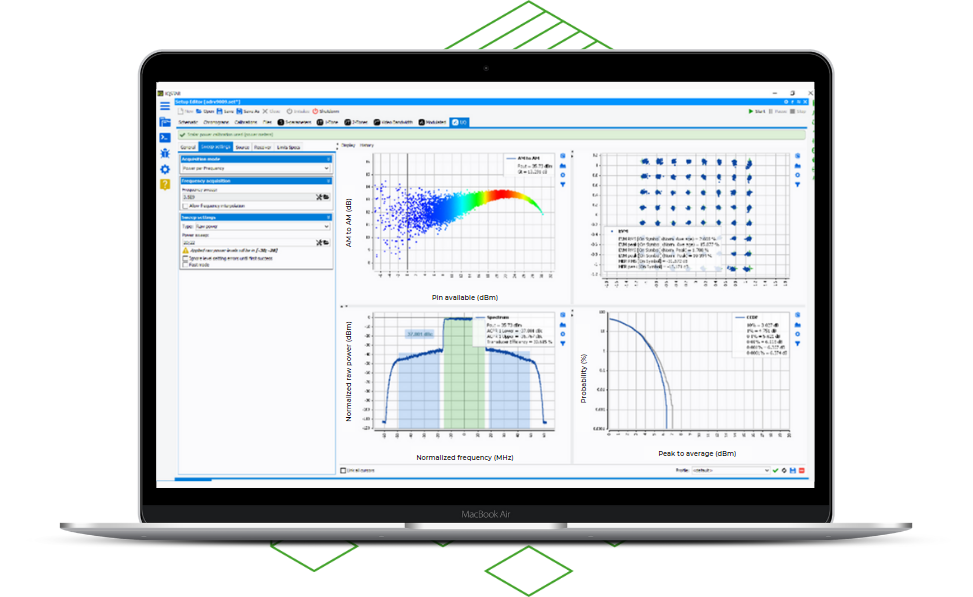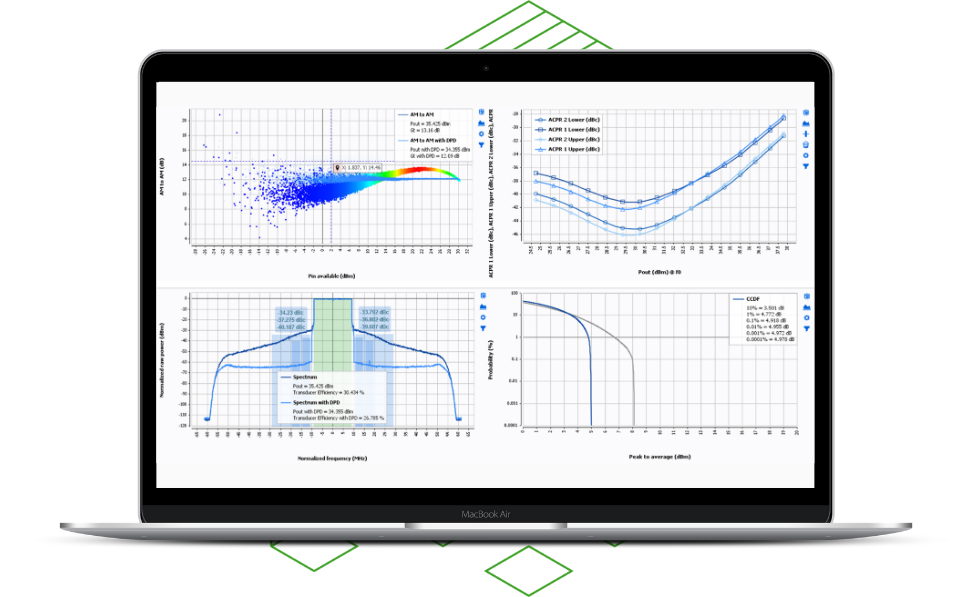
The Digital Pre-distortion for Power amplifiers linearization is imposed by the new RF systems and RF frontends applications and designs. With the constant increase in the number channels, bandwidth, data throughput and antenna elements, stringent specifications are required for power, efficiency and system footprint.
The competitive market for Power Amplifiers with the new 5G networks imposes rigorous specifications that must be considered during the measurements phase. The setup should allow a full characterization using modulated signals and evaluate the degree of linearization the Power amplifier can achieve by measuring the Adjacent Channel Power Ratio (ACPR) or the Error Vector Magnitude (EVM). Customers impose different criteria; therefore, the application engineer should run different measurements under different conditions to support the end user.
Digital Predistortion (DPD) is used to linearize power amplifiers and enable a higher output power and efficiency while reducing the non-linearity to acceptable levels by the system integrators. The DPD applies a controlled distortion of the input signal to compensate for the non-linearity generated by the power amplifier at the output. Depending on the circuit design and technology used, the DPD algorithm must overcome different phenomena impacting a power amplifier’s linearity, including high- and low-frequency memory effects.
Power amplifier measurements using IQ signal
The characterization of power amplifiers for linearization imposes the use of a vector signal generator (VSG) to generate the wideband signal, a vector signal analyzer (VSA) to measure the magnitude and phase of the modulated signal, power sensors at the input and output of the DUT to measure the average power and power supplies for the device biasing.

The IQ data is acquired from the VSA, resized and realigned with the input signal. The analysis of the data is done in IQSTAR to extract different parameters:
- IQ data
- ACPR
- EVM on signal
- CCDF with Trace
- Dynamic AM-AM
- Dynamic AM-PM
- PAPR
Depending on the test procedures adopted by each company to qualify the design specifications, it is possible to combine frequency and power sweeps. Still, one must indicate stop conditions to limit the average output power, the PAPR compression, or other parameters to ensure safe power amplifier testing.
With IQS100B-40 of IQSTAR, no software options are required in the instruments to analyze the signal, making it a scalable solution with minimum hardware updates. The only limitation is the instantaneous bandwidth of the VSG and VSA.

IQSTAR embeds an IQ Measurement Interval Selection Tool to speed up the measurement process, identifying the most appropriate signal segment that best represents the original one regarding statistical characteristics. This feature is very useful when a trade-off between measurement speed and accuracy is required.
The live visualization tool in IQSTAR offers customizable displays saved by test engineers for their different characterization steps. Different filters are available to visualize the data at specific stimulus or compression conditions during and after the measurements.
Digital Predistortion for power amplifier linearization
Power amplifiers are the most important and intrinsically nonlinear parts of a communication system. The non-linearity causes spectrum regrowth, which violates the rules for out-of-band emission and causes interference with adjacent channels. The bit error rate (BER) performance is also harmed by in-band distortion brought on by the non-linearity. Allowing the power amplifier to operate in the linear region can reduce the non-linearity and its effects. Nonetheless, the low efficiency of the power amplifier in these operating conditions renders this approach inapplicable. Power amplifiers must be linearized to increase power efficiency and enhance linearity.
Power amplifier designers must convince their customers that their device can be linearized, but in some cases, it is insufficient. They need to demonstrate that the linearization algorithm is not too complex and does not require large computing capabilities, which would reduce the system’s overall efficiency.
IQSTAR DPD module IQS100B-41 is an add-on to the IQS100B-40 IQ data control and measurements. It enables some DPD algorithms and techniques for the user to test on the device and ensure that his device can be linearized.
Here is the list of the algorithms available for the test engineer:
- Sample-based
- This method, which is measurement-based and iterative, enables the achievement of nearly ideal linearization results for reference. Since it cannot be employed as a real-time DPD algorithm in a transmitter, this approach is only used during the PA verification and development phase
- Memoryless (M)
- Memoryless models focus on the power amplifier with a memoryless non-linearity: the output at a specific signal time depends only on the input at the same signal timing through a nonlinear mechanism. The AM/AM and AM/PM responses typically indicate this instantaneous non-linearity. The power amplifier’s output signal amplitude and phase deviation are supplied as functions of the input amplitude.
- Memory Polynomial (MP)
- The memory model is frequently used as the signal bandwidth widens and the power amplifiers show memory effects, especially for high-power amplifiers used in wireless base stations. As a result, the current and past input values affect the power amplifier’s current output.
- Generalized Memory Polynomial (GMP)
- This model is built by augmenting the polynomial memory order considering the cross-term order. The user can set different parameters, like the polynomial order, the memory depth, the log order and depth, and the lead order and depth.
- Nanosemi Single-band Algorithm (DLL to be acquired by the customer)
- This option controls the Nanosemi single-band algorithm through a DLL and applies it externally to the measurements using instruments from different vendors. The Nanosemi DLL must be acquired separately.
- Nanosemi Dual-Band Algorithm (DLL to be acquired by the customer)
- This option controls the Nanosemi dual-band algorithm through a DLL and applies it externally to the measurements using instruments from different vendors. The Nanosemi DLL must be acquired separately.
- Matlab-Based Customer-Developed DPD Algorithm
- This option is a gateway to run a Matlab-based DPD algorithm developed by the user. This option also offers an Open-source MP algorithm that the user can adjust and optimize to his power amplifier under test. Matlab licenses must be acquired separately.

Becoming an expert in managing DPD algorithms and measurement settings takes time. To make this task more accessible, IQSTAR has a number of options available:
- Emission and reception transient signals are automatically aligned
- Measurement receivers’ dynamic range is automatically optimized (auto-leveling)
- Triggers signals are managed
- Measurement speed optimization using IQ signal Interval Selection Tool
- Post-processing on the data is provided for different plots (AM / AM, AM / PM, CCDF, ACPR …)
- The linearization can be performed with a user-defined number of iterations
- In the case of a homemade DPD algorithm developed with a proprietary program (Matlab-based), it’s possible to evaluate the related performances on the bench using the (IQS100B-41) module, with all the figures of merits and instrument control functionalities at hand.
- Agnostic control of instruments for signal generation and measurement: Take control of the solution without obstacles. Standardize the operation of the different test benches in the lab. Make the most of the investments by unifying test procedures and sharing results obtained within a working group.

